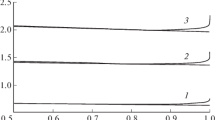Abstract
The proposed model of intermolecular interactions contains three independent groups of quantities describing non-polar forces, polar forces, and hydrogen bonds. The contribution of hydrogen bonding to the total energy of intermolecular interaction is represented as a product of some quantum-mechanical threshold value and the probability of molecular arrangement that makes this bonding possible. Two characteristics, “polarity” and “hydrophilicity”, distinguishing polar and non-polar species, are introduced. Along with the generalized charge, these characteristics are independent arguments of the three-parameter model for liquid phases used in chromatography. The model is applied to describe the interaction of polar molecules in the gas phase with liquid polyethylenee glycol (PEG). Theoretical dependences of PEG polarity and hydrophilicity on the polymer′s molecular mass are derived. The graph of these dependences plotted in “polarity–hydrophilicity” coordinates agrees well chromatography data for characteristics of PEGs used as stationary phases.

Similar content being viewed by others
REFERENCES
N. D. Sokolov. Usp. Fiz. Nauk, 1955, 57, 205.
P. Hobza. Annu. Rep. Prog. Chem., Sect. C: Phys. Chem., 2004, 100, 3.
J. J. Dannenberg, L. Haskamp, and A. Masunov. J. Phys. Chem. A, 1999, 103, 7083.
S. J. Grabowski. J. Phys. Chem. A, 2011, 115, 12789.
R. A. Provencal, R. N. Casaes, K. J. B. Paul, C. N. Chapo, R. J. Saykally, G. S. Tschumper, and H. F. Schaefer. J. Phys. Chem. A, 2000, 104, 1423.
B. G. Oliveira and M. L. A. A. Vasconcellos. J. Mol. Struct: THEOCHEM, 2006, 774, 83.
P. Farfan, A. Echeverri, E. Diaz, J. D. Tapia, S. Gómez, and A. Restrepo. J. Chem. Phys., 2017, 147, 044312
A. M. Dolgonosov. Sorbtsionnye Khromatogr. Protsessy, 2015, 15, 312.
A. M. Dolgonosov. J. Struct. Chem., 2020, 61(7), 1045.
A. M. Dolgonosov. J. Struct. Chem., 2019, 60(11), 1693.
A. M. Dolgonosov. Model′ Elektronnogo Gaza i Teoriya Obobschennykh Zaryadov Dlya Opisaniya Mezhatomnykh Vzaimodeistviy i Adsorbtsii (Electron Gas Model and Theory of Generalized Charges for Description of Interatomic Interactions) [in Russian]. LIBROKOM: Moscow, 2009.
A. M. Dolgonosov. Russ. J. Phys. Chem. A, 2001, 75, 1659.
A. M. Dolgonosov. Russ. J. Phys. Chem. A, 2002, 76, 993.
A. M. Dolgonosov. Nespetsificheskaya Selektivnost′ v Probleme Modelirovaniya Vysokoeffektivnoy Khromatografii (Nonspecific Selectivity in the Problem of Modeling of High-performance Chromatography) [in Russian]. KRASAND: Moscow, 2012.
A. M. Dolgonosov. Russ. J. Inorg. Chem., 2019, 64, 488.
I. G. Kaplan. Intermolecular Interactions: Physical Picture, Computational Methods, and Model Potentials. Wiley, 2006.
M. H. Abraham. J. Phys. Organic Chem., 1993, 6, 660.
A. M. Dolgonosov and E. A. Zaitceva. Sorbtsionnye Khromatogr. Protsessy, 2015, 15, 321.
E. A. Zaitceva and A. M. Dolgonosov. Sorbtsionnye Khromatogr. Protsessy, 2018, 18, 676.
E. A. Zaitceva and A. M. Dolgonosov. Sorbtsionnye Khromatogr. Protsessy, 2019, 19, 525.
A. M. Dolgonosov. Russ. Chem. Bull., 2016, 65, 952.
Gas Chromatographic Retention Data. https://webbook.nist.gov/chemistry/gc-ri. Accessed 31.01.2020.
A. M. Dolgonosov. Prot. Met. Phys. Chem. Surf., 2015, 51, 951
A. M. Dolgonosov, A.G. Prudkovsky. Russ. J. Phys. Chem. A, 2006, 80, 964.
P. J. Schoenmakers. J. Chromatogr. Libr., 1986, 35, 344.
Z. Juvancz, T. Cserhaiti, K. E. Markides, J. S. Bradshaw, and M. L. Lee. Chromatographia, 1994, 38(3/4), 227.
The Retention Index System in Gas Chromatography: McReynolds Constants, Sigma-Aldrich Co., 1997. https://www.sigmaaldrich.com/Graphics/ Supelco/objects/7800/7741.pdf. Accessed 30.01.2020.
A. Yu. Grosberg and A. R. Khokhlov. Statistical physics of macromolecules. American Institute of Physics: New York, 1994.
Funding
The reported study was funded by RFBR, project number 18-03-00382а.
Author information
Authors and Affiliations
Corresponding author
Ethics declarations
The authors declare that they have no conflict of interests.
Rights and permissions
About this article
Cite this article
Dolgonosov, A.M., Zaitсeva, E.A. A MODEL OF INTERMOLECULAR INTERACTION ASSOCIATED WITH HYDROGEN BOND FORMATION AND ITS APPLICATION TO THE CHARACTERIZATION OF THE SELECTIVITY OF CHROMATOGRAPHIC PHASES ON THE EXAMPLE OF POLYETHYLENE GLYCOLS. J Struct Chem 61, 1233–1243 (2020). https://doi.org/10.1134/S0022476620080089
Received:
Revised:
Accepted:
Published:
Issue Date:
DOI: https://doi.org/10.1134/S0022476620080089




